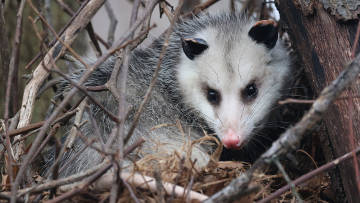

PHOTO COURTESY OF GARRY KESSLER
An opossum
May 3, 2019, Page A8-A9
NATURE NOTES
By Annie Reid
Westborough Community Land Trust
Our local marsupial
We’ve all heard of marsupials – those mammals that carry their developing young around in a pouch – but did you know we have one in our local woods? If you’ve glimpsed an opossum, you’ve seen the only marsupial in the United States and Canada.
The Virginia opossum (Didelphis virginiana) is probably more common than you might think. You might have noticed a road-killed opossum, or spotted a live one eating rotting fruit, suet or birdseed or even cat food left outside. Or perhaps you’ve seen its somewhat star-shaped tracks in snow or mud. Walkers at the Westborough Community Land Trust’s tracking walk in January got good looks at opossum tracks at the state wildlife management area in Westborough.
Our “possums” aren’t easy to see. They’re about the size of a housecat and are usually light gray with a white, pointed face and pink nose. They’re loners and wanderers, active mainly at night, and they spend time in trees as well as on the ground. If you happen to spot one walking, you’ll see that it seems to move slowly and kind of awkwardly. They don’t hibernate, so you might see one at any time of year.
It’s now the breeding season for our only marsupial (February to June). So how does reproduction work with a pouch? Female opossums have not one uterus, but two. There the young begin development, but only for two weeks. Then they’re born and crawl over the mother’s fur to her pouch. At this point they’re tiny – the size of a raisin, dime or honeybee. Inside the pouch are 13 nipples arranged in a circle, and the young latch on and stay that way for about the next two months. Many more than 13 are born, so all do not survive. When ready, the young climb out of the pouch onto the mother’s back. After a couple of months of riding and following her, they become independent.
Virginia opossums are famous for “playing dead.” When threatened, an opossum might hiss and bare its teeth, run away or climb a tree, but if the danger is great and retreat unlikely, it will fall over in an unconscious, death-like state lasting up to several hours. This behavior seems to be a reflex of sorts, not a deliberate act of pretending. People have been known to pick up an opossum in this state and carry it around by the tail (but please don’t try this). Once danger passes, the opossum revives.
What else is unusual about opossums? For one, their long, rat-like tail is prehensile, meaning it can grasp things. This ability is useful for walking along branches, or for carrying leaves or grass while climbing. Also, on each back foot opossums have an opposable “thumb” that can close against their other four toes, so they can grasp a branch with their back feet and hang upside-down.
Finally, opossums have 50 teeth, more than any other land mammal in the United States and Canada. They eat all sorts of things – fruit, plants, insects, worms, mice, frogs, carrion, garbage. They groom themselves thoroughly, and in the process consume any ticks on their body. They’re not especially susceptible to rabies, probably because their body temperature is lower than that of other mammals.
How did we end up with a marsupial? Opossums came here, not from Australia (land of marsupials like kangaroos), but from South America. North and South America were once separate, but they were joined by a land bridge about 3 million years ago. A great interchange followed, with South American plants and animals moving northward and North American plants and animals moving southward. Even today there are 9 species of opossum in Costa Rica, and our Virginia opossum is continuing to expand its range northward into Canada.